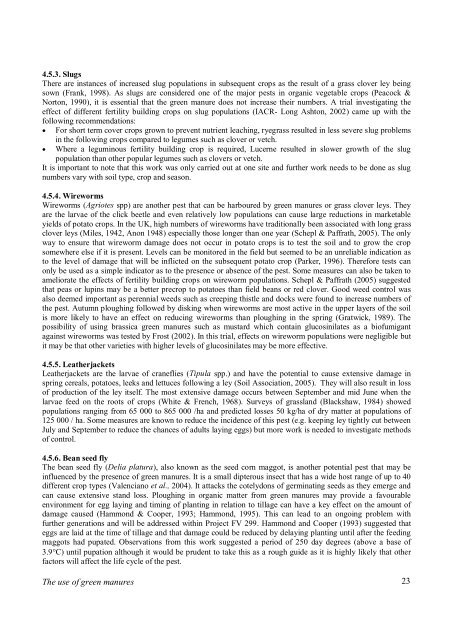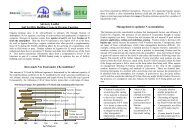Green Manures booklet - Institute of Organic Training and Advice
Green Manures booklet - Institute of Organic Training and Advice
Green Manures booklet - Institute of Organic Training and Advice
Create successful ePaper yourself
Turn your PDF publications into a flip-book with our unique Google optimized e-Paper software.
4.5.3. Slugs<br />
There are instances <strong>of</strong> increased slug populations in subsequent crops as the result <strong>of</strong> a grass clover ley being<br />
sown (Frank, 1998). As slugs are considered one <strong>of</strong> the major pests in organic vegetable crops (Peacock &<br />
Norton, 1990), it is essential that the green manure does not increase their numbers. A trial investigating the<br />
effect <strong>of</strong> different fertility building crops on slug populations (IACR- Long Ashton, 2002) came up with the<br />
following recommendations:<br />
• For short term cover crops grown to prevent nutrient leaching, ryegrass resulted in less severe slug problems<br />
in the following crops compared to legumes such as clover or vetch.<br />
• Where a leguminous fertility building crop is required, Lucerne resulted in slower growth <strong>of</strong> the slug<br />
population than other popular legumes such as clovers or vetch.<br />
It is important to note that this work was only carried out at one site <strong>and</strong> further work needs to be done as slug<br />
numbers vary with soil type, crop <strong>and</strong> season.<br />
4.5.4. Wireworms<br />
Wireworms (Agriotes spp) are another pest that can be harboured by green manures or grass clover leys. They<br />
are the larvae <strong>of</strong> the click beetle <strong>and</strong> even relatively low populations can cause large reductions in marketable<br />
yields <strong>of</strong> potato crops. In the UK, high numbers <strong>of</strong> wireworms have traditionally been associated with long grass<br />
clover leys (Miles, 1942, Anon 1948) especially those longer than one year (Schepl & Paffrath, 2005). The only<br />
way to ensure that wireworm damage does not occur in potato crops is to test the soil <strong>and</strong> to grow the crop<br />
somewhere else if it is present. Levels can be monitored in the field but seemed to be an unreliable indication as<br />
to the level <strong>of</strong> damage that will be inflicted on the subsequent potato crop (Parker, 1996). Therefore tests can<br />
only be used as a simple indicator as to the presence or absence <strong>of</strong> the pest. Some measures can also be taken to<br />
ameliorate the effects <strong>of</strong> fertility building crops on wireworm populations. Schepl & Paffrath (2005) suggested<br />
that peas or lupins may be a better precrop to potatoes than field beans or red clover. Good weed control was<br />
also deemed important as perennial weeds such as creeping thistle <strong>and</strong> docks were found to increase numbers <strong>of</strong><br />
the pest. Autumn ploughing followed by disking when wireworms are most active in the upper layers <strong>of</strong> the soil<br />
is more likely to have an effect on reducing wireworms than ploughing in the spring (Gratwick, 1989). The<br />
possibility <strong>of</strong> using brassica green manures such as mustard which contain glucosinilates as a bi<strong>of</strong>umigant<br />
against wireworms was tested by Frost (2002). In this trial, effects on wireworm populations were negligible but<br />
it may be that other varieties with higher levels <strong>of</strong> glucosinilates may be more effective.<br />
4.5.5. Leatherjackets<br />
Leatherjackets are the larvae <strong>of</strong> craneflies (Tipula spp.) <strong>and</strong> have the potential to cause extensive damage in<br />
spring cereals, potatoes, leeks <strong>and</strong> lettuces following a ley (Soil Association, 2005). They will also result in loss<br />
<strong>of</strong> production <strong>of</strong> the ley itself. The most extensive damage occurs between September <strong>and</strong> mid June when the<br />
larvae feed on the roots <strong>of</strong> crops (White & French, 1968). Surveys <strong>of</strong> grassl<strong>and</strong> (Blackshaw, 1984) showed<br />
populations ranging from 65 000 to 865 000 /ha <strong>and</strong> predicted losses 50 kg/ha <strong>of</strong> dry matter at populations <strong>of</strong><br />
125 000 / ha. Some measures are known to reduce the incidence <strong>of</strong> this pest (e.g. keeping ley tightly cut between<br />
July <strong>and</strong> September to reduce the chances <strong>of</strong> adults laying eggs) but more work is needed to investigate methods<br />
<strong>of</strong> control.<br />
4.5.6. Bean seed fly<br />
The bean seed fly (Delia platura), also known as the seed corn maggot, is another potential pest that may be<br />
influenced by the presence <strong>of</strong> green manures. It is a small dipterous insect that has a wide host range <strong>of</strong> up to 40<br />
different crop types (Valenciano et al., 2004). It attacks the cotelydons <strong>of</strong> germinating seeds as they emerge <strong>and</strong><br />
can cause extensive st<strong>and</strong> loss. Ploughing in organic matter from green manures may provide a favourable<br />
environment for egg laying <strong>and</strong> timing <strong>of</strong> planting in relation to tillage can have a key effect on the amount <strong>of</strong><br />
damage caused (Hammond & Cooper, 1993; Hammond, 1995). This can lead to an ongoing problem with<br />
further generations <strong>and</strong> will be addressed within Project FV 299. Hammond <strong>and</strong> Cooper (1993) suggested that<br />
eggs are laid at the time <strong>of</strong> tillage <strong>and</strong> that damage could be reduced by delaying planting until after the feeding<br />
maggots had pupated. Observations from this work suggested a period <strong>of</strong> 250 day degrees (above a base <strong>of</strong><br />
3.9°C) until pupation although it would be prudent to take this as a rough guide as it is highly likely that other<br />
factors will affect the life cycle <strong>of</strong> the pest.<br />
The use <strong>of</strong> green manures<br />
23




